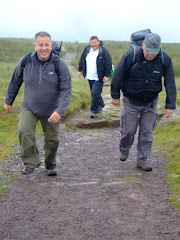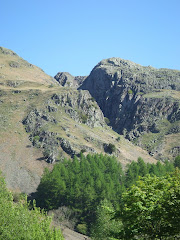
It was an extremely local walk this morning, under a crisp almost cloud free sky with a bright, low autumn sun.
There was plenty of company from the cawing of the magpies, to the red breasts of the robins and singing of the blackbirds.

After leaving Rhydycar within ten minutes the leisurely stroll arrives at Lower Abercanaid, first passing Quay Row some listed cottages and then Pond Row on the Upper Tramroad.

The trail was originally launched in September 1988 by Sir Wyn Roberts, Minister of State for the Welsh Office. The project was initiated and co-ordinated by the Merthyr and Cynon Groundwork Trust, with the co-operation of the local councils that the trail passes through. Financial and logistical support has been given by the Welsh Development Agency and Sustrans, a sustainable transport charity.

Arriving at Upper Abercanaid, unfortunately, it was still way too early to call into the Llwyn Yr Eos, which has been serving the locals for over two hundred years. However, I expect that Lord Twynyrodyn, Butterballs, Brownie and yours truly will make a visit during a balmy evening next summer.

Before the trail was conceived, several similar and disjointed facilities existed in the area. Taff Ely Borough Council had created cycling routes within its boundaries, Cardiff City Council had provided the Three Castles Cycle Route from Caerphilly into Cardiff, and the Brecon Beacons National Park was developing leisure trails to encourage the use of the park. The Groundwork Trust for Merthyr Tydfil and Rhondda Cynon Taf saw a need for the co-ordination of these efforts, and the Taff Trail was born.


On the short journey between Abercanaid and Troedyrhiw I passed the Dynevor Arms but it was still too early to open its doors! The majority of people that I passed were all out for an early morning walk with their dogs, which was precisely what former Plymouth Ward Councillor Ron Clarke was doing when I was passing him. We walked together for half a mile talking about various things before I also met someone that I used to work with a few years ago who was walking her parents dog - the shy but extremely handsome, Maxie.
There were also some mountain bikers (perfect route for cycling) and a few joggers.

The trail makes much use of an abandoned branch of the Taff Vale Railway and the Glamorganshire Canal. These had been built in the 18th and 19th century to transport coal and iron ore from Merthyr Tydfil and the Rhondda Valley to the docks at Cardiff and Barry. The canals had become disused due to competition from the railways, and the railways in turn had become surplus to requirement as the heavy industries upon which they depended closed. These routes, which although disused had remained largely intact, proved ideal for the needs of the trail, providing a convenient path along the narrow base of the Taff Valley.
The trail continues to follow the A470 as far as Aberfan, where it descends below the road and continues through mainly residential areas.
I briefly left the trail to visit the Memorial Garden that was constructed to remember those who lost their lives in the Aberfan Disaster of 1966, before I returned to the trail and retraced the earlier route back to Rhydycar.

This provided me with an appetite for some home made cawl for lunch, before settling down to watch South Africa beat Wales 29-25 at the Millennium Stadium, which is located just a few miles from the actual start of the southern end of the Taff Trail.

The walk was 7 miles and took just over two hours to complete. Mainly because there were no metres of ascent! All of the photographs taken on this walk can be viewed
here. Select 'slide-show' for automated viewing.












 This particular section starts at the Community Centre and alongside St. Johns Church is a very narrow path that very soon crosses a bridge over the A465.
This particular section starts at the Community Centre and alongside St. Johns Church is a very narrow path that very soon crosses a bridge over the A465.










 Samuel Homfray (a local ironmaster) was so impressed with Trevithick's locomotive that he made a bet with another ironmaster, Richard Crawshay, for 500 guineas that Trevithick's steam locomotive could haul 10 tons of iron along the Merthyr Tydfil Tramroad from Penydarren to Abercynon, a distance of 9.75 miles (16 km). Amid great interest from the public, on 21 February 1804 it successfully carried 10 tons of iron, 5 wagons and 70 men the full distance in 4 hours and 5 minutes, an average speed of approximately 2.4 mph (3.9 km/h)
Samuel Homfray (a local ironmaster) was so impressed with Trevithick's locomotive that he made a bet with another ironmaster, Richard Crawshay, for 500 guineas that Trevithick's steam locomotive could haul 10 tons of iron along the Merthyr Tydfil Tramroad from Penydarren to Abercynon, a distance of 9.75 miles (16 km). Amid great interest from the public, on 21 February 1804 it successfully carried 10 tons of iron, 5 wagons and 70 men the full distance in 4 hours and 5 minutes, an average speed of approximately 2.4 mph (3.9 km/h) The nature reserve, where herons, otters, foxes and kingfisher can be seen, must be a twitchers delight with the large number of native British birds that were seen during this brief section.
The nature reserve, where herons, otters, foxes and kingfisher can be seen, must be a twitchers delight with the large number of native British birds that were seen during this brief section.











 On the short journey between Abercanaid and Troedyrhiw I passed the Dynevor Arms but it was still too early to open its doors! The majority of people that I passed were all out for an early morning walk with their dogs, which was precisely what former Plymouth Ward Councillor Ron Clarke was doing when I was passing him. We walked together for half a mile talking about various things before I also met someone that I used to work with a few years ago who was walking her parents dog - the shy but extremely handsome, Maxie.
On the short journey between Abercanaid and Troedyrhiw I passed the Dynevor Arms but it was still too early to open its doors! The majority of people that I passed were all out for an early morning walk with their dogs, which was precisely what former Plymouth Ward Councillor Ron Clarke was doing when I was passing him. We walked together for half a mile talking about various things before I also met someone that I used to work with a few years ago who was walking her parents dog - the shy but extremely handsome, Maxie.
































